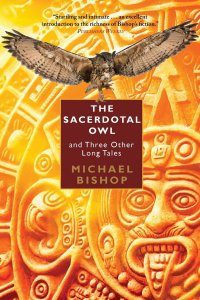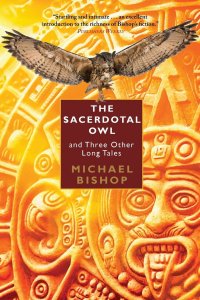Gary K. Wolfe Reviews The Sacerdotal Owl and Three Other Long Tales by Michael Bishop
 The Sacerdotal Owl and Three Other Long Tales, Michael Bishop (Fairwood Press/Kudzu Planet 978-1-933846-72-9, $17.99, 282pp, tp) August 2018.
The Sacerdotal Owl and Three Other Long Tales, Michael Bishop (Fairwood Press/Kudzu Planet 978-1-933846-72-9, $17.99, 282pp, tp) August 2018.
Michael Bishop has been defining his own uniquely eclectic brand of humanistic SF since his emergence as one of the most prominent new writers of the 1970s, and it’s likely that this has been both good and bad news for his career. On the one hand, he’s given us works that veer wildly from time-traveling anthropological SF to Vancean far futures to theocratic dystopias to alternate histories involving Philip K. Dick and Richard Nixon to classic Southern realism to what remains one of the best homages to Frankenstein – and in the cast of the latter two, in the same novel (Brittle Innings). On the other, this leads to uncomfortable contortions when we try to fit him into the identifiable movements and trends that emerged along with his own career – not quite a New Humanist, not quite a post-cyberpunk, not quite a Southern Gothicist, but not quite not, either. For the last several years, Fairwood Press has been reissuing revised and corrected editions of his earlier works, and last year published Other Arms Reach Out to Me: Georgia Stories, a collection of mainstream tales which earlier this year earned him a “Georgia Author of the Year” award. That “Georgia author” rubric may as close as we need to come to try to pigeonhole him.
The Sacerdotal Owl and Three Other Long Tales brings together – again with revisions – two stories from fairly early in Bishop’s career and two from the last 15 years. The earliest, And Strange at Ecbatan the Trees, dates from 1976, when it was published as Bishop’s second novel. As Bishop notes in an afterword, that weirdly obscure literary title (a line from Archibald MacLeish’s poem “You, Andrew Marvell”, whose theme the story echoes) was too much for Donald Wollheim, so the DAW books paperback was retitled Beneath the Shattered Moons, which (as Bishop also notes) makes it sound like a slanted tribute to Edgar Rice Burroughs. In fact, it’s more of a tribute to Jack Vance, with its distant future setting, its mix of medievalism and high technology, and its fascination with the subversive power of art. It’s set on the planet Mansueceria, settled some six thousand years earlier by “neo-humans” from Earth as a kind of experiment in biosocial engineering: the population is divided into “stoically disciplined” maskers and the “more aggressive, more emotional Atarites.” This has more or less kept things stable, with the maskers occupying the island of Ongladred and the Atarites retreated to other islands, although a couple of legendary cataclysms have threatened the colony’s survival. One threat involves the sloak, a supposed giant membrane that lives under the sea and periodically overwhelms the land; another involves raids from the Atarites. To make matters worse, there is now concern that the local star might erupt at any time.
One characteristic Bishop move is to shift the terms of the narrative, if not the entire genre, in midstream (Brittle Innings contains one of the most startling narrative pivots in all of SF). Here he begins in Ongladred with what seems to be an espionage tale – the narrator is a spy sent to keep an eye on a poet and dramatist named Gabriel Elk, who uses advanced technology to create dramatic tableaux by reanimating corpses (since the resolutely unartistic maskers are prohibited from pretending to be anything they’re not). But when the island is threatened by raiders, he is recruited to use his skills to develop new weapons, and the narrator becomes his chief assistant. Somehow, what had been a story about the uses of art in an artless society becomes a fast-moving naval adventure, with wooden frigates up against laser weapons. There’s a surprising amount of invention packed into this ambitious tale – perhaps a bit too much, taking on questions about the social functions of art and science to the moral issue of large-scale social engineering, but Bishop manages to create a memorable and provocative character in Gabriel Elk.
Similarly, the title story “The Sacerdotal Owl” begins with echoes of Conrad and perhaps even Lucius Shepard, as the protagonist arrives in “the guerilla-besieged Central American country of Guacamayo” to meet her archaeologist-fiancé, who seems to have disappeared. She meets and rather quickly falls in love with a local poet, who offers to take her on the hazardous inland journey to find her husband – it turns out he’s been captured by the guerillas – but once they get there, the story shifts into full pulp-adventure mode, with double-crosses, sudden murders, and unlikely hairbreadth escapes. Somehow, Bishop unites all this by keeping his main character both convincing and complex.
Both “To the Land of Snow” and “The Gospel According to Gamaliel Crucis; or, The Astrogator’s Testimony” approach themes of religion from Bishop’s characteristic slanted angles. The former is a generation starship story, but the starship is inhabited by 990 Buddhists fleeing oppression in China (it’s not clear what happened to the millions left behind), narrated in the form of journal entries from a girl who is told she may be the new Dalai Lama (and that the old one, also on board, may have been murdered). Again, the voice of the girl shifts the focus of the story into an affecting coming-of-age tale. “The Gospel According to Gamaliel Crucis” also takes an unusual form, in numbered paragraphs meant to resemble Bible verses, but here the purpose is largely satirical: an insectoid alien civilization, facing a surplus of messiahs, sends one back to Earth, where it performs a series of miracles and eventually brings on the wrath of a fundamentalist sect determined to destroy it. Recalling at times the more acerbic work of James Morrow, it’s a useful reminder that Bishop, for all his weighty themes and tricky narrative shifts, can also be downright hilarious.
Gary K. Wolfe is Emeritus Professor of Humanities at Roosevelt University and a reviewer for Locus magazine since 1991. His reviews have been collected in Soundings (BSFA Award 2006; Hugo nominee), Bearings (Hugo nominee 2011), and Sightings (2011), and his Evaporating Genres: Essays on Fantastic Literature (Wesleyan) received the Locus Award in 2012. Earlier books include The Known and the Unknown: The Iconography of Science Fiction (Eaton Award, 1981), Harlan Ellison: The Edge of Forever (with Ellen Weil, 2002), and David Lindsay (1982). For the Library of America, he edited American Science Fiction: Nine Classic Novels of the 1950s in 2012, with a similar set for the 1960s forthcoming. He has received the Pilgrim Award from the Science Fiction Research Association, the Distinguished Scholarship Award from the International Association for the Fantastic in the Arts, and a Special World Fantasy Award for criticism. His 24-lecture series How Great Science Fiction Works appeared from The Great Courses in 2016. He has received six Hugo nominations, two for his reviews collections and four for The Coode Street Podcast, which he has co-hosted with Jonathan Strahan for more than 300 episodes. He lives in Chicago.
This review and more like it in the December 2018 issue of Locus.
 While you are here, please take a moment to support Locus with a one-time or recurring donation. We rely on reader donations to keep the magazine and site going, and would like to keep the site paywall free, but WE NEED YOUR FINANCIAL SUPPORT to continue quality coverage of the science fiction and fantasy field.
While you are here, please take a moment to support Locus with a one-time or recurring donation. We rely on reader donations to keep the magazine and site going, and would like to keep the site paywall free, but WE NEED YOUR FINANCIAL SUPPORT to continue quality coverage of the science fiction and fantasy field.







